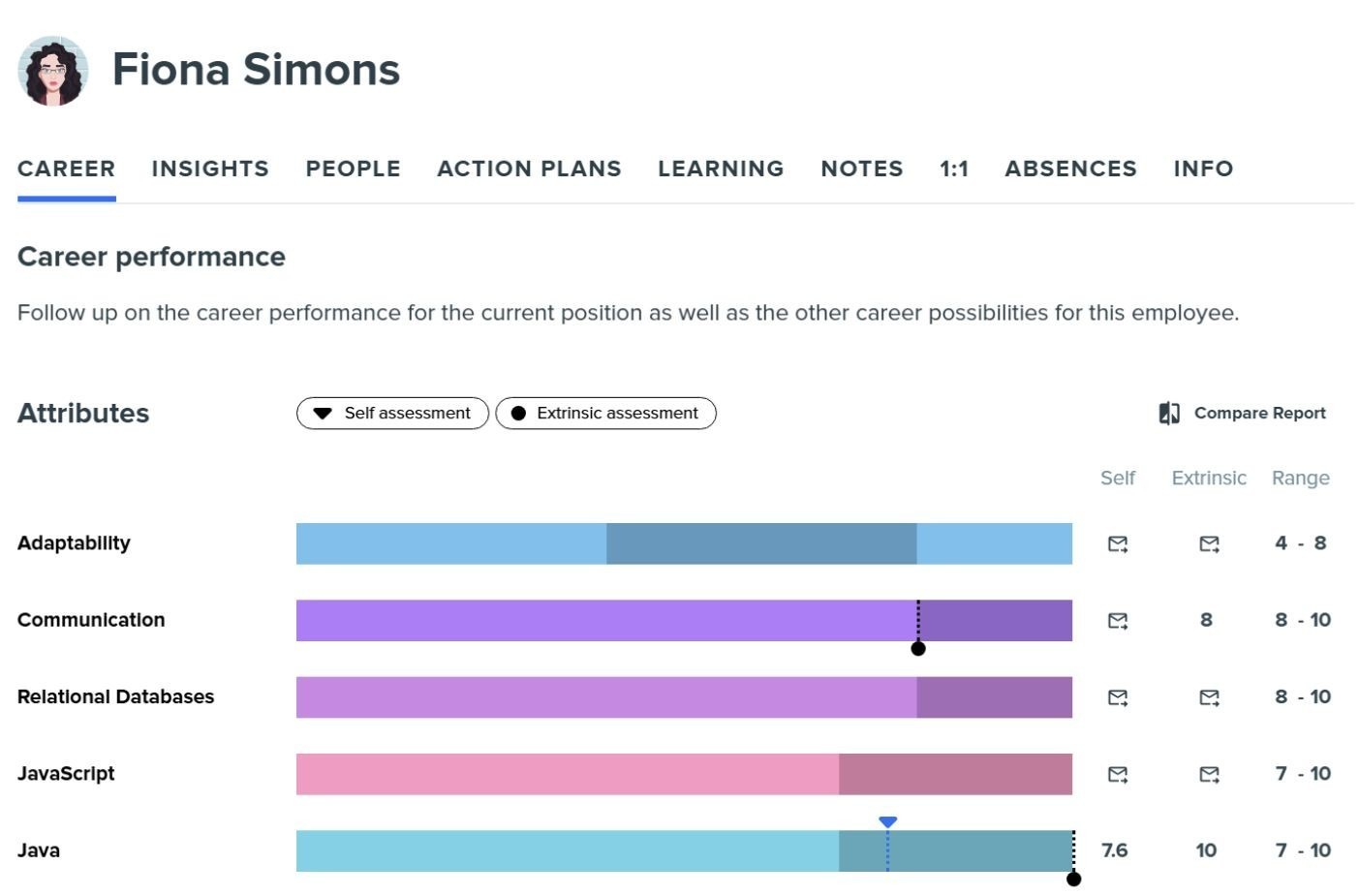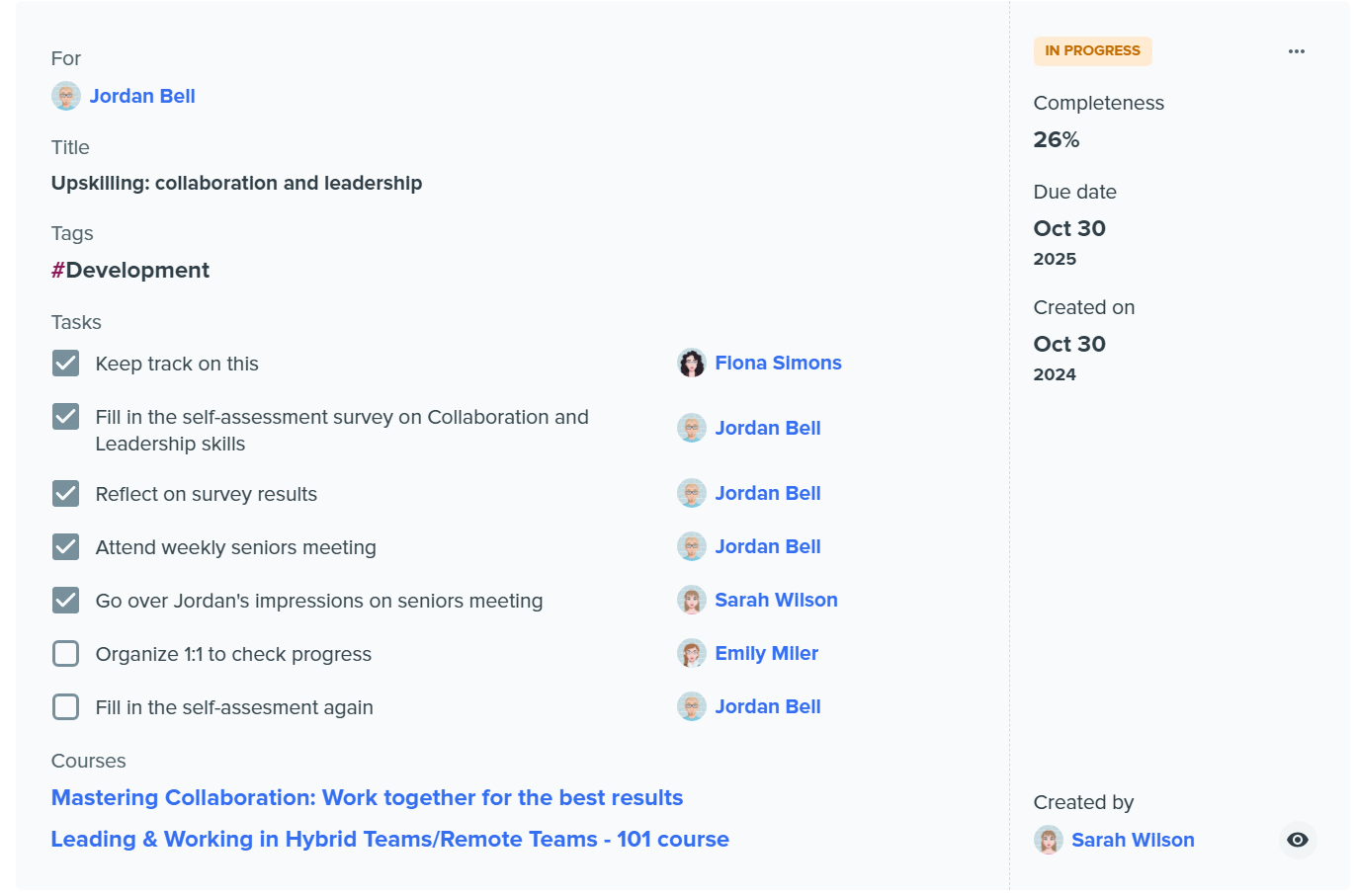Most tech organizations say they want a culture of feedback. It’s written into values, repeated at all-hands meetings, and mentioned during onboarding. However, in practice, feedback often occurs late, inconsistently, or not at all.
Managers avoid giving it unless it’s urgent. C-level executives view it as “nice to have” rather than something that brings results. And HR is left trying to push feedback as a value without the tools, support, or structure to make it stick.
This gap between intention and execution is the reason most feedback cultures fail. They rely on enthusiasm, not systems. On individual managers, not shared expectations. And when feedback does happen, it often remains invisible, with no follow-up, no learning, and no development. Just another conversation, easily forgotten.
This article breaks down how to build a feedback culture that works. One that managers know how to use, leaders see as a business driver, and HR can support through coaching, repetition, and structure.
Why feedback culture often fails in tech organizations
People generally want feedback, but in most growing tech teams, no one is responsible for making it happen. It’s treated as a personal preference rather than an organizational norm. Whether feedback flows depends on individual managers, informal habits, or whether HR happens to run a review cycle that month.
When that’s the setup, the 360 feedback loop never gets established. It fires up occasionally (during performance reviews, after conflict, or when someone is about to leave), but it doesn’t shape daily decisions or development. Instead of being a tool for clarity and growth, feedback becomes a background expectation. Everyone agrees it’s important, but no one knows who’s supposed to make it work.
Common reasons feedback culture breaks down:
- There’s no rhythm: feedback happens only when something’s wrong.
- There’s no visibility: even when feedback is shared, no one knows what came of it.
- There’s no direction: feedback rarely leads to action or growth.
- There’s no ownership: HR might push it, but managers don’t feel accountable.
- There’s no signal: C-level doesn’t connect feedback to business outcomes
💡 A Gallup study found that only 26% of employees strongly agree that the feedback they receive helps them do better work, and just 1 in 5 believe their performance is managed in a motivating way.
When feedback stays invisible, it loses all impact, and without clear expectations or structure, it’s only a matter of time before the entire process is deprioritized.
What needs to be true for a consistent feedback loop to work
Creating a culture of feedback isn't about encouraging people to “speak up” more; it's about building the infrastructure that makes feedback reliable, expected, and valuable. Without rhythm, visibility, and clear direction, even the best-intentioned efforts lose momentum.
Rhythm: feedback needs a predictable place in the workflow
Feedback should happen regularly, not just when something goes wrong. That means anchoring it to processes teams already use, such as 1:1 meetings, project retros, and performance cycles. When employees know when to expect feedback, they’re more open to hearing it and more likely to give it themselves.
What doesn’t work: feedback as a reaction to problems.
What does: feedback as a built-in part of the work, brief, timely, and regular.
Visibility: what’s said should be seen and followed up on
In most teams, feedback disappears after the conversation. There’s no record, no reflection, no system to track how it connects to development. Without visibility, people are unaware of what was learned, changed, or missed, and managers lose a valuable tool for coaching.
A consistent feedback loop requires shared context:
- Who said what
- In which format
- Linked to which goals or behaviors
- With what follow-up
Direction: feedback must lead somewhere
Even when feedback is well-intentioned, it fails if it doesn’t point to something actionable. Employees need to know what it means for their role, career development, or next step. Otherwise, it becomes just another data point with no impact.
That’s where many systems fall short: they collect feedback but fail to act on it. A strong feedback culture ties every input to learning, growth, or adjustment, even if it’s small.
How Microsoft’s “growth mindset” initiative boosted engagement
When Microsoft moved away from traditional performance reviews, it wasn’t just replacing a process; it was reshaping the culture. Under Satya Nadella, the company introduced a growth mindset philosophy that emphasized continuous learning, curiosity, and collaboration.
As part of that transformation, Microsoft replaced rigid stack-ranking systems with development-focused conversations and coaching-based leadership. Feedback became more regular, integrated into day-to-day work, and grounded in shared goals.
The shift: Instead of waiting for annual cycles, Microsoft focused on creating space for continuous feedback between managers and employees, supported by rituals, storytelling, and new reward systems that encouraged experimentation and growth.
With this change, managers were trained to act as coaches, asking open-ended questions, encouraging reflection, and helping employees take ownership of their development. On the other hand, employees began to see feedback not as judgment, but as part of the learning process.
The impact:
- Feedback became part of everyday work, not just a review event.
- Employee engagement was reported to have increased, with a renewed sense of purpose.
- Risk-taking and collaboration were rewarded, reducing fear and encouraging innovation.
Why it matters for your feedback culture:
- Feedback rhythms were built into the way work is done through team rituals, shared reflections, and leadership modeling.
- Managers and employees moved from one-directional evaluations to mutual conversations about growth.
- More tools didn’t drive the cultural change, but consistency, transparency, and intentional leadership did.
Microsoft’s example shows what’s possible when feedback becomes a habit and when growth is treated as a shared responsibility, not a personal gamble.
For HR, adoption starts with coaching, selling, and repeating
Even the best feedback system fails if no one uses it. That’s why HR’s role isn’t just to design processes but to activate them. This means helping managers lead differently, gaining buy-in from leadership, and reinforcing the value of feedback until it becomes second nature.
This takes more than training slides or Slack reminders. It requires genuine influence and a well-planned approach.
Start with the managers, or nothing sticks
Managers are the engine of any feedback culture. If they don’t know how to give feedback, react to it, or turn it into development, the entire system stalls. HR has to start here, not by overwhelming them, but by making the process easier to follow and repeat.
That means:
- Showing how feedback improves team performance and reduces friction
- Modeling good feedback in HR’s interactions with them
- Tracking usage and stepping in when it drops
If managers don’t own the process, no one will.
Sell feedback to leadership with business logic
C-level won’t support a feedback system unless they understand what it changes. HR’s job is to connect input to what leadership cares about: performance, retention, clarity, and speed.
Make the case clearly:
- Show how poor feedback leads to slow decision-making and repeated mistakes
- Use data from past reviews or 1:1s to illustrate gaps
- Tie feedback to outcomes: promotions, churn, and team velocity
Leaders don’t resist feedback because they’re against it. They resist it because they don’t see the ROI. HR has to make that link obvious.
Repeat it until it’s normal
One-pagers and kickoff calls don’t change behavior. Repetition does. Feedback culture requires HR to deliver the same message consistently — in every onboarding, every performance review, and every manager check-in. That feedback is not optional, and it’s not extra work. It’s how the team gets better.
How Kadar supports an authentic feedback culture (not just surveys)

Most HR tools let you collect feedback. Kadar helps you build a system around it, one that makes feedback visible, actionable, and part of how your teams grow.
In Kadar, feedback isn’t stored away in spreadsheets or forgotten after a quarterly review. It’s integrated into the entire performance workflow, from evaluations to 1:1s to development tracking, so that managers and employees know where things stand and what needs to happen next.
Feedback is part of the system, not a side process

- Self, peer, and manager feedback are collected simultaneously in the same cycle.
- Teams can compare perceptions, see patterns, and align on the next steps.
- Every evaluation connects directly to action plans and skills development, with no follow-up documents required.
Managers don’t have to guess; they see what matters

- 1:1s are pre-loaded with insights from the latest feedback.
- Suggested talking points help guide conversations based on development themes.
- Managers can track whether action plans are being followed without leaving the platform.
HR gets a signal, not just sentiment

- Real-time reports show where feedback is happening, where it’s missing, and how teams are responding.
- Instead of reading survey comments and guessing, HR sees measurable patterns and momentum.
- You don’t need a separate dashboard; insights are built in.
Kadar doesn’t just make feedback easier to collect. It makes it easier to act on, and that’s what builds an authentic culture.
Feedback culture doesn’t work without structure
If feedback is optional, it gets skipped. If it’s vague, it gets ignored. And if it doesn’t lead to action, it doesn’t matter.
That’s why building a feedback culture isn’t about launching initiatives; it’s about embedding structure, visibility, and accountability into everyday work.
Managers need a system they can rely on. Leadership requires a reason to invest. And HR needs a way to keep it all moving.
Kadar gives you precisely that. One connected place to collect feedback, track progress, and make conversations matter.
👉 Try it today for free and build a feedback culture that sticks.


